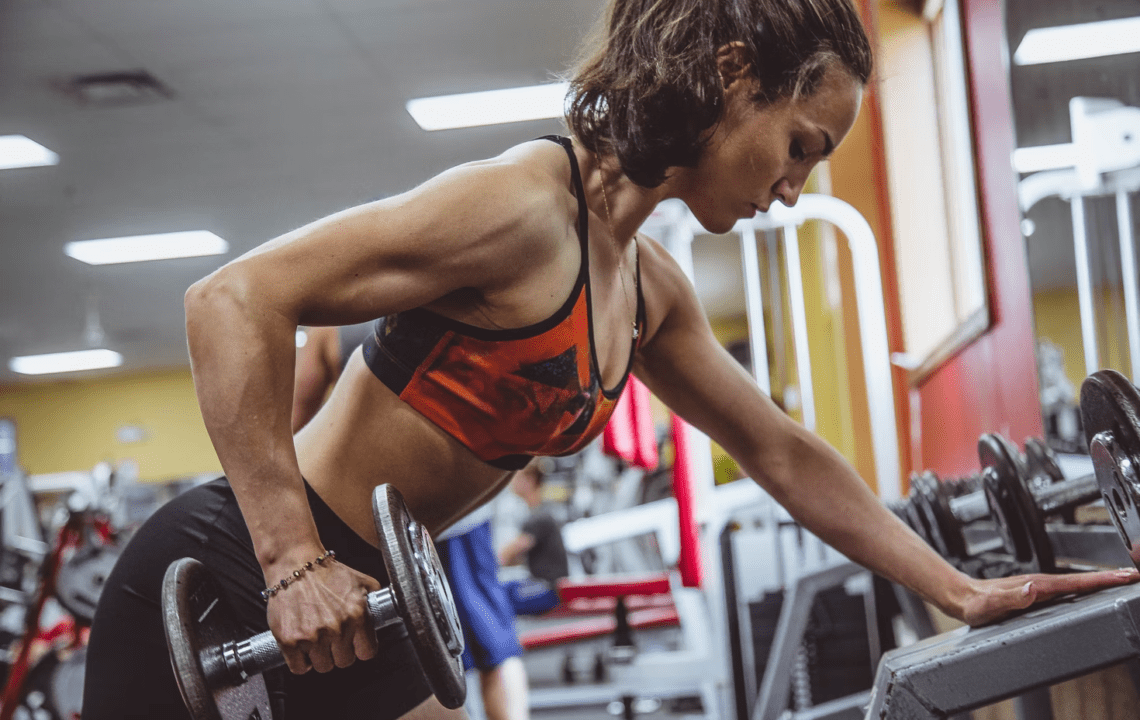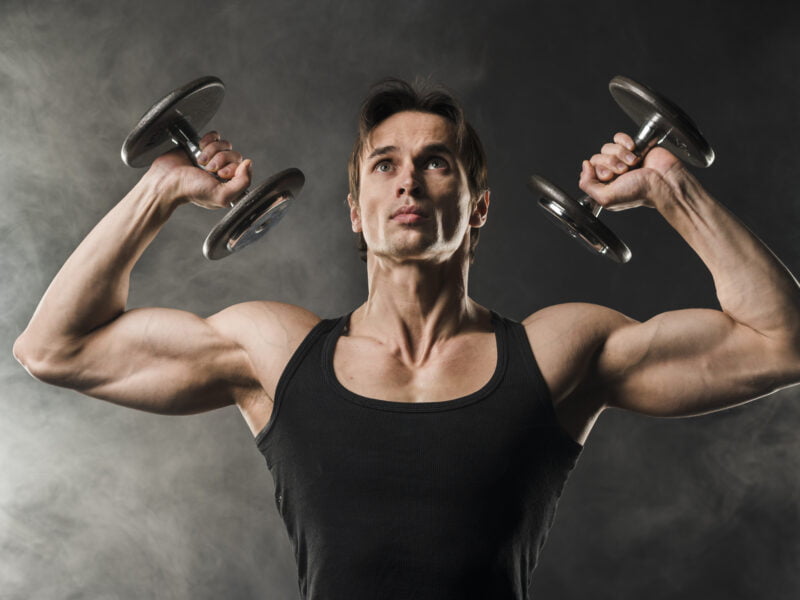Think all bicep curls are created equal? It’s time to curl up and rethink your strategy!
A bicep workout isn’t just a nice-to-have; it’s essential for balanced muscle development. Research shows that the biceps brachii account for about 30% of the upper arm’s muscle mass.
It is clear why bicep curls should be an important segment of your workout routine. But doing the same exercise can be a tab monotonous. This blog is here to save you from the repetitive cycle of standard curls.
We’ll explore the multitude of benefits that bicep curls bring and introduce you to 11 powerful variations to enhance your arm workouts.
Whether you’re new to fitness or a seasoned athlete, we’ve got a bicep curl variation for everyone.
Benefits of Bicep Curls
Bicep curls are not just about aesthetics; they bring numerous benefits that contribute to overall upper body strength and functionality. According to the National Institutes of Health, strength training exercises like bicep curls can increase muscle mass, improve bone density, and enhance metabolic rate, leading to better weight management and reduced risk of chronic diseases.
Bicep curls target the biceps brachii, a muscle crucial for arm flexion and supination. Strengthening this muscle can improve performance in various sports and daily activities that involve lifting, pulling, and carrying. Strong biceps also support the elbow joint and stabilize the shoulder, reducing the risk of strains and overuse injuries.
Strength training, including bicep curls, can boost mental health by reducing symptoms of anxiety, depression, and stress. AND… A well-developed bicep enhances the appearance of the arms.
11 Best Bicep Curls Variations
The American Council on Exercise highlights that a balanced strength training program, including bicep curls, can improve posture and reduce back pain. To help you build your biceps here is a list of 11 exercises:
1. Standard Bicep Curl
The standard bicep curl is the most basic form of the exercise. This exercise primarily targets the biceps brachii, promoting hypertrophy and strength.
How to Perform:
- Stand with feet shoulder-width apart, holding a barbell or dumbbell with an underhand grip.
- Keep your elbows close to your torso.
- Curl the weights while contracting your biceps.
- Continue to raise the weights until your biceps are fully contracted and the weights are at shoulder level.
- Slowly lower the weights back to the starting position.
2. Hammer Curl
This variation targets the brachialis, a muscle underneath the biceps brachii, and the brachioradialis in the forearm. Studies have shown that hammer curls can lead to greater activation of these muscles compared to standard curls.
How to Perform:
- Stand with feet shoulder-width apart, holding dumbbells at your sides with a neutral grip.
- Keep your elbows close to your torso.
- Curl the weights while keeping your palms facing inward.
- Continue to raise the weights until your biceps are fully contracted.
- Slowly lower the weights back to the starting position.
3. Concentration Curl
This bicep curl reduces the involvement of other muscle groups, ensuring maximum tension on the biceps.
How to Perform:
- Sit on a bench with your legs spread and feet flat on the floor.
- Hold a dumbbell in one hand, resting your upper arm on the inside of your thigh.
- Curl the weight up while contracting your biceps.
- Continue to raise the weight until your biceps are fully contracted.
- Slowly lower the weight back to the starting position.
4. Preacher Curl
Preacher curls are done using a preacher bench, which helps to eliminate momentum and further isolate the biceps.
How to Perform:
- Sit on a preacher’s bench with your arms over the bench pad.
- Hold a barbell or dumbbells with an underhand grip.
- Curl the weights while contracting your biceps.
- Continue to raise the weights until your biceps are fully contracted.
- Slowly lower the weights back to the starting position.
5. Incline Dumbbell Curl
Research has shown that incline dumbbell curls can lead to greater biceps activation compared to other variations.
How to Perform:
- Set an incline bench to a 45-degree angle.
- Sit on the bench with a dumbbell in each hand, arms hanging straight down.
- Curl the weights while contracting your biceps.
- Continue to raise the weights until your biceps are fully contracted.
- Slowly lower the weights back to the starting position.

6. Zottman Curl
Zottman curls combine the standard curl and reverse curl into one exercise. It targets both the biceps brachii and the forearm muscles.
How to Perform:
- Stand with feet shoulder-width apart, holding dumbbells with an underhand grip.
- Curl the weights while contracting your biceps.
- At the top of the movement, rotate your wrists to a pronated grip.
- Slowly lower the weights back to the starting position with palms facing down.
7. Cable Curl
Using a cable machine, cable curls offer constant tension throughout the movement, which can enhance muscle growth.
How to Perform:
- Attach a straight bar to a low pulley on a cable machine.
- Stand with feet shoulder-width apart, holding the bar with an underhand grip.
- Curl the bar while contracting your biceps.
- Continue to raise the bar until your biceps are fully contracted.
- Slowly lower the bar back to the starting position.
8. Spider Curl
Spider curls focus on the peak contraction of the biceps, promoting muscle definition and strength.
How to Perform:
- Set an incline bench to a 45-degree angle.
- Lie face down on the bench with a dumbbell in each hand.
- Curl the weights while contracting your biceps.
- Continue to raise the weights until your biceps are fully contracted.
- Slowly lower the weights back to the starting position.
9. Reverse Curl
Reverse curls involve holding the barbell or dumbbells with a pronated grip (palms facing down). It targets the brachioradialis and the brachialis, developing the forearms and the outer biceps.
How to Perform:
- Stand with feet shoulder-width apart, holding a barbell with an overhand grip.
- Keep your elbows close to your torso.
- Curl the bar while contracting your biceps.
- Continue to raise the bar until your biceps are fully contracted.
- Slowly lower the bar back to the starting position.
10. Resistance Band Curl
This bicep curl variation maintains tension on the biceps throughout the entire range of motion and can be performed anywhere, making it convenient for home workouts.
How to Perform:
- Stand in the middle of a resistance band, holding the handles with an underhand grip.
- Keep your elbows close to your torso.
- Curl the handles while contracting your biceps.
- Continue to raise the handles until your biceps are fully contracted.
- Slowly lower the handles back to the starting position.
11. Cross-Body Curl
Cross-body curls target the brachialis and add variety to your routine, preventing monotony and promoting balanced muscle development.
How to Perform:
- Stand with feet shoulder-width apart, holding a dumbbell in each hand.
- Curl one dumbbell across your body towards the opposite shoulder while keeping your palm facing inward.
- Return to the starting position and repeat with the other arm.
Mistakes To Avoid While Doing Bicep Curls
According to a study published in the Journal of Strength and Conditioning Research, lifting with proper form is more effective for muscle activation than using heavier weights with poor form. Improper posture and too much or too little weight are some of the common mistakes that you make while doing bicep curls. To build strong, toned biceps you need to avoid such mistakes. Here is a list of mistakes that you need to avoid:
- Using Too Much Weight
- Partial Reps
- Incorrect Grip
- Neglecting Warm-Up
- Overtraining
Parting Thought
Each bicep curl targets different parts of the biceps and surrounding muscles, ensuring complete muscle engagement and growth as explained above. Gradually increasing the weight and intensity of your workouts, with dedication and the right approach, will give you significant results in no time.
The American College of Sports Medicine recommends at least 48 hours of rest between strength training sessions for biceps. So, rest and recovery are as important as it is to perform bicep curls with the correct posture and technique.
If you experience pain or discomfort, consider consulting a fitness professional or a healthcare provider to ensure you’re on the right track.




![Does Using Crutches Build Muscle: Complete Guide [Updated]](https://supeshealth.com/wp-content/uploads/2024/03/full-shot-smiley-man-training-800x600.jpg)
